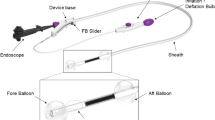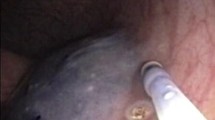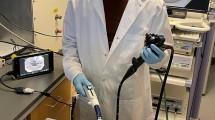Abstract
Background
Experimental models of colorectal tumor require either laparotomy for induction or anastomosis following resection. The long murine cecum avoids the need for an anastomosis, making the cecum the preferred site for induction. This study aimed to evaluate total colonoscopy with submucosal injection of cecal wall (TCWI) in rats in terms of failure rate (FR), complication rate (CR), and reproducibility (R).
Methods
A bolus of bowel prep was given. Anesthesia was injected intraperitoneally. A video fiberscope (5.9 mm outer diameter, 180/90° up/down bending, 100/100° right/left bending, 103 cm working length, 120° view field, and 2.0 mm channel) allowed for irrigation and suction. Saline 1 ml was injected in the cecal wall through a 4-mm-long, 23-gauge needle placed on a 3-mm wire, resulting in a blister. FR was a failure to reach and inject the cecum. Rats were allowed to recover. CR was measured at necropsy. R was assessed by comparing TCWI time, FR, and CR for three investigators. Sample size of 120 (type I error, 0.05; power, 80%) was based on a pilot study. Data are presented as median (range).
Results
A total of two of 122 rats (1.6%) died after prep or anesthesia. Bowel prep resulted in 99.1% evacuation of solid feces. A total of 120 male Sprague–Dawley retired breeders weighing 592 g (range, 349–780) underwent TCWI. Scope depth was 28 cm (range, 20–36). Irrigating fluid was 290 ml (range, 100–600). TCWI time was 7 min (range, 4–28). FR was 4%. In three failed cases, the scope reached the ascending colon. CR was 2%. There were two perforations in the ascending colon. All three operators had similar TCWI time (p = 0.673), FR (p > 0.1), and CR (p > 0.1). A total of 98.3% of rats survived to planned sacrifice. At 48-h necropsy, the injection site was macroscopically identified in 118 rats.
Conclusions
A safe and reproducible TCWI rat model has been achieved, which may provide a valuable tool in the future for studies of solid colorectal tumors.

Similar content being viewed by others
References
Allendorf JDF, Bessler M, Whelan RL (1997) A murine model of laparoscopic-assisted intervention. Surg Endosc 11: 622–624
Balague C, Braumann C, Fuhrer K, Guski H, Jacobi CA (2001) Validation of a new experimental model of colon cancer. Surg Endosc 15: 833–836
Basu A, Wexner SD, Bergamaschi R (2003) Validity of current experimental evidence on laparoscopic surgery for colorectal cancer. Surg Endosc 17: 179
Gutt CN, Riemer V, Kim ZG, Jacobi CA, Paolucci V, Lorenz M (1999) Impact of laparoscopic colonic resection on tumor growth and spread in an experimental model. Br J Surg 86: 1180–1184
Hamilton SR, Zhang SZ, O’Ceallaigh D, McAvinchey D (1986) Growth characteristics of autochthonous experimental colonic tumors as assessed by serial colonoscopic measurements in rats. Gastroenterology 91: 1511–1520
Huang Earter JJ, Whelan RL, Liu YH, Rosenberg JO, Rotterdam H, Schmidt AM, Stern DM, Forde KA (2002) Colonoscopy in mice. Surg Endosc 16: 22–24
Hull CC, Stellato T, Ament A, Gordon NH, Galloway P (1990) Endoscopic and radiographic evaluation of the murine colon. Cancer 66: 2528–2532
Narisawa T, Wong CQ, Weisburger JH (1975) Evaluation of endoscopic examination of colon tumors in rats. Dig Dis 20: 928–934
Pauwels M, Lauwers P, Hendriks J, Hubens A, Eyskens E, Hubens G (1999) The effect of CO2 pneumoperitoneum on the growth of a solid colon carcinoma in rats. Surg Endosc 13: 998–1000
Pocard M, Debruyne P, Bras-Goncalves R, Mareel M, Dutrillaux B, Poupon MF (2001) Single alteration of p53 or E-cadherin genes can alter the surgical resection benefit in an experimental model of colon cancer. Dis Colon Rectum 44: 1106–1112
Tomita H, Marcello PW, Milsom JW, Gramlich TL, Fazio VW (2001) CO2 pneumoperitoneum does not enhance tumor growth and metastasis: study of a rat cecal wall inoculation model. Dis Colon Rectum 44: 1297–1301
Author information
Authors and Affiliations
Corresponding author
Additional information
An erratum to this article is available at http://dx.doi.org/10.1007/s00464-006-3033-5.
Rights and permissions
About this article
Cite this article
Haughn, C., Uchal, M., Raftopoulos, Y. et al. Development of a total colonoscopy rat model with endoscopic submucosal injection of the cecal wall. Surg Endosc 20, 270–273 (2006). https://doi.org/10.1007/s00464-005-0088-7
Received:
Accepted:
Published:
Issue Date:
DOI: https://doi.org/10.1007/s00464-005-0088-7




